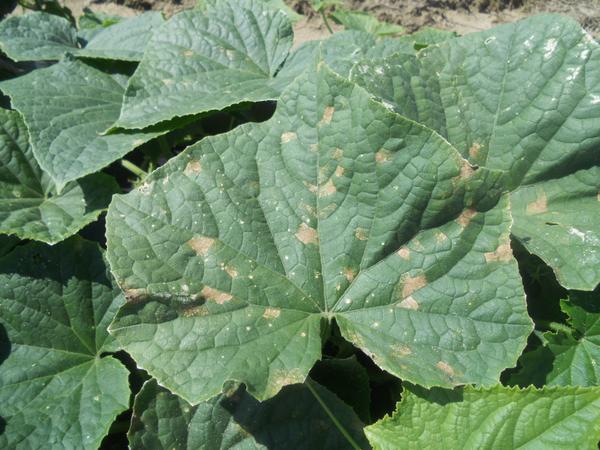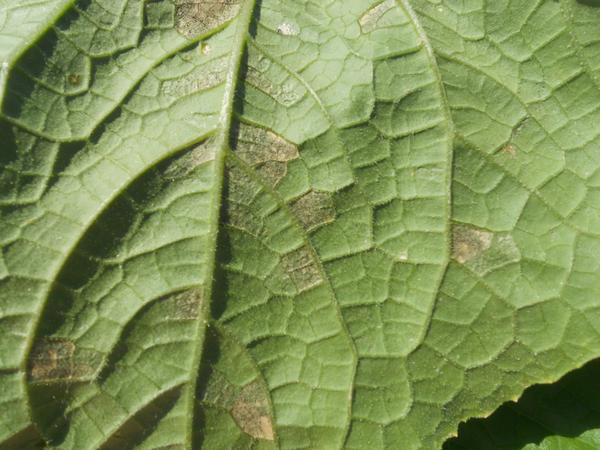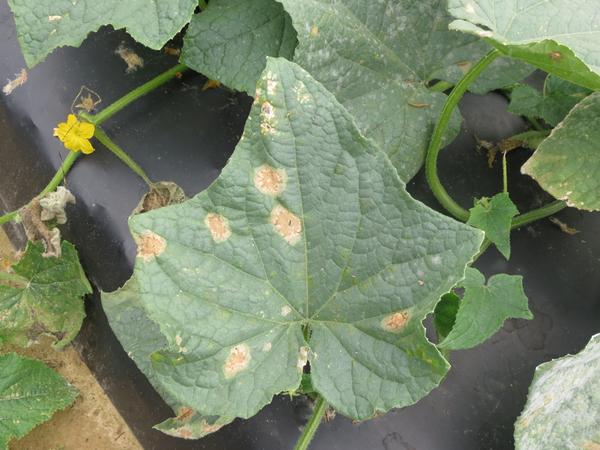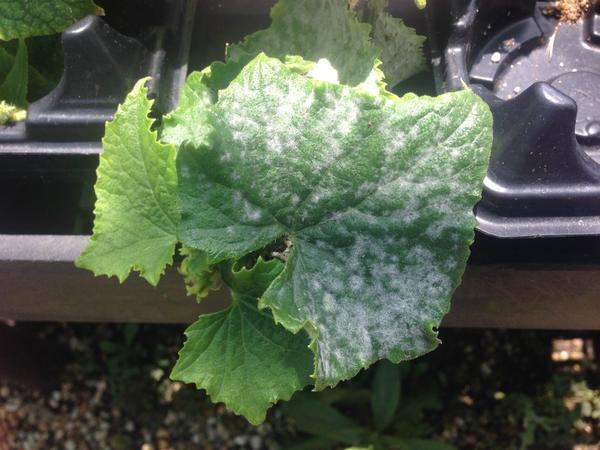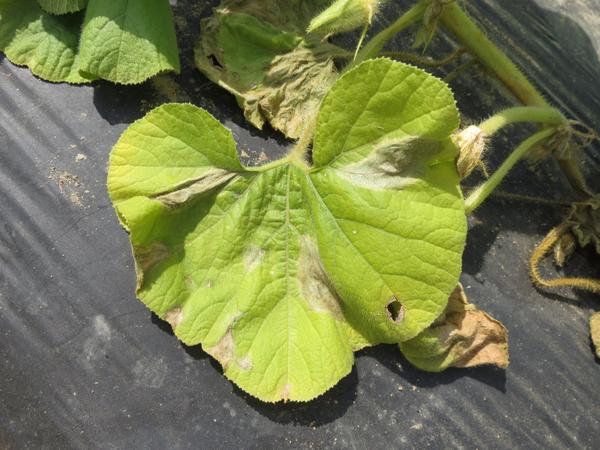Pathogen
Cucurbit downy mildew is caused by the fungus-like oomycete pathogen Pseudoperonospora cubensis (P. cubensis). There are two types of P. cubensis isolates that can infect cucurbit crops and weeds referred to as clade 1 or clade 2 isolates. Isolates belonging to clade 1 tend to more frequently infect watermelon, pumpkin, and squash while isolates belonging to clade 2 more frequently infect cucumber and cantaloupe. Isolates belonging to clade 2 can quickly become resistant to fungicides, thus, fewer effective fungicides ara available for downy mildew control in cucumber and cantaloupe.
Host Crops and Plants
Cucurbit crops such as cucumber, watermelon, melon, cantaloupe, squash, and pumpkin.
Host Parts Affected
Leaves are severely affected, which can result in yield reduction or plant death.
Identification
Downy mildew causes angular, yellow to brown lesions on top of the leaves that are restricted by leaf veins (Figure 1). When conditions are favorable, for example early in the morning when moisture is higher, lesions observed on the underside of the leaf may be covered in dark “down” (Figure 2). This downy growth is masses of pathogen spores called sporangia, which can be seen in the field with a 20X hand lens. These spores germinate to produce the pathogen and infect leaves. Identification of downy mildew can be more difficult in watermelon and cantaloupe than in cucumber since lesions do not always have the characteristic angular shape, but spores on the underside of the leaf can provide additional evidence of the pathogen.
Similar Diseases
Downy mildew is often confused with other foliar diseases such as:
- Alternaria leaf blight, caused by Alternaria cucumerina (Figure 3)
- Angular leaf spot, caused by Pseudomonas psyringae pv. lachrymans (Figure 4)
- Anthracnose, caused by Colletotrichum orbiculare (Figure 5)
- Powdery mildew, caused by Podosphaera xanthii or Erysiphe cichoracearum, note white powdery growth on the leaf surface (Figure 6)
- Phytophthora leaf blight, caused by Phytophthora capsici (Figure 7)
Favorable Environmental Conditions for the Disease
- High-humidity and moisture (6-12 hours of moisture are ideal and usually occur as morning dew, rain or overhead irrigation).
- Cool temperatures (~60°F).
- In North Carolina, the disease typically begins in June and lasts throughout the growing season.
Disease Transmission
Pathogen spores can be transported from state to state through air currents. The pathogen needs a living host to survive and it can only overwinter on plants in sites with warm weather such as the Southern United States and greenhouses. Spores come to North Carolina every year from infected plants in surrounding states or in greenhouses with year-round production.
General Disease Management
- Plant early in the season to escape high disease pressure
- Do not allow water to remain on leaves for long periods of time
- Scout plants often and remove infected plants
- Sign up to receive alerts at the Cucurbit Downy Mildew IPM Pipe website and report any outbreaks to prevent others
- Plant tolerant varieties when possible
- Protect the crop with fungicides
Disease Control for Conventional Growers
Chemical control
Fungicides are required to control cucurbit downy mildew. Before disease appears apply fungicides at 7-day interval for cucumbers and 10-day intervals for other cucurbits. After disease is detected in your area apply fungicides at 5-day interval for cucumbers and 7-day intervals for other cucurbits. Alternate products and tank mix with mancozeb or chlorothalonil to avoid generating fungicide-resistant strains. For the latest fungicide recommendations for cucurbit downy mildew see the Southeastern US Vegetable Crop Handbook. Fungicide labels are legal documents, always read and follow fungicide labels.
| Active ingredient | Example product | Pre-harvest Interval (day) | Fungicide group |
|---|---|---|---|
| Cyazofamid | Ranman 400 SC | 0 | 21 |
| Fluazinam | Omega 500 F | 7 | 29 |
| Chlorothalonil + oxathiapiprolin | Orondis Opti | 0 | M05+49 |
| Mandipropamid + oxathiapiprolin | Orondis Ultra | 0 | 40+49 |
| PropamocarbG | Previcur Flex 6F | 2 | 28 |
| Ethaboxam | Elumin 4SC | 2 | 22 |
| Mancozeb + zoxamideG | Gavel 75DF | 5 | M03+22 |
| Chlorothalonil + zoxamide | Zing! | 0 | M05+22 |
| MancozebG | Dithane 75DF Rainshield | 5 | M03 |
| Chlorothalonil | Bravo Weather Stik 6SC | 0 | M05 |
| G Can be used in greenhouses, see label for restrictions | |||
For example, in cucumber before disease is reported in the state you can use: Ranman + Bravo, alternated with Elumin + Bravo, alternated with Omega + Bravo every 7 days.
After disease is reported in the state you can use: Ranman + Bravo, alternated with Previcur Flex + Bravo, alternated with Orondis Opti every 5 to 7 days, with the shorter interval if the weather is wet and cool. Once the disease is reported in the state, using the highest rate labeled for products will result in better control and lower risk of fungicide resistance. Because rain favors this disease, when possible protect crops before and after a rain event. Check label for restrictions of number of applications to plan your program.
| Active ingredient | Example product | Pre-harvest Interval (day) | Fungicide group |
|---|---|---|---|
| Cyazofamid | Ranman 400 SC | 0 | 21 |
| Fluazinam | Omega 500 F | 7 | 29 |
| Chlorothalonil + oxathiapiprolin | Orondis Opti | 0 | M05+49 |
| Mandipropamid + oxathiapiprolin | Orondis Ultra | 0 | 40+49 |
| PropamocarbG | Previcur Flex 6F | 2 | 28 |
| Ametoctradin + dimethomorph | Zampro 4.38 SC | 0 | 45+40 |
| Ethaboxam | Elumin 4SC | 2 | 22 |
| Mancozeb + zoxamideG | Gavel 75DF | 5 | M03+22 |
| Chlorothalonil + zoxamide | Zing! | 0 | M05+22 |
| Fluopicolide | Presidio 4F | 2 | 43 |
| Famoxadone + cymoxanilG | Tanos 50WG | 3 | 11+27 |
| MancozebG | Dithane 75DF Rainshield | 5 | M03 |
| Chlorothalonil | Bravo Weather Stik 6SC | 0 | M05 |
| G Can be used in greenhouses, see label for restrictions | |||
For example, in squash before disease is reported in the state you can use: Presidio + Bravo, alternated with Zampro + Bravo, alternated with Tanos + Bravo every 10 days.
After disease is reported in the state you can use: Ranman + Bravo, alternated with Previcur Flex + Bravo, alternated with Orondis Opti every 7 to 10 days, with the shorter interval if the weather is wet and cool. Once the disease is reported in the state, using the highest rate labeled for products will result in better control and lower risk of fungicide resistance. Because rain favors this disease, when possible protect crops before and after a rain event. Check label for restrictions of number of applications to plan your program.
Host resistance
Most cucumber varieties commercially available are resistant to P. cubensis clade 1 isolates but there is no resistance available for clade 2 isolates. For pickling cucumber the varieties Citadel and Peacemaker from Seminis are tolerant to clade 2 isolates causing cucumber downy mildew. For slicing cucumber the varieties SV3462CS and SV4142CL are tolerant to clade 2 isolates causing cucumber downy mildew. Greenhouse growers are strongly recommended to use there tolerant varieties since chemical control options in a greenhouse are very limited and the risk of fungicide resistance is very high.
Disease Control for Organic Growers
Organic growers have less chemical options that are effective; the only OMRI labeled active ingredients that have some efficacy against cucurbit downy mildew are fixed copper formulations.
Disease Control for Home Gardeners
Unmanaged gardens can become a source of inoculum for commercial plantings, thus, it is important that home owners are actively scouting their plants for downy mildew. Home gardeners should plant early and destroy plants if they become infected. Planting tolerant varieties is also strongly recommended because most chemicals available to the home gardener are not sufficient to control cucurbit downy mildew once it appears. For pickling cucumber the varieties Citadel and Peacemaker from Seminis are tolerant to cucumber downy mildew. For slicing cucumber the varieties SV3462CS and SV4142CL. Products containing the active ingredients copper or chlorothalonil (the trade name of one product with chlorothalonil is known as ‘Daconil’) are the best and only effective products available to home gardeners.
Useful Resources
- The NC State University Plant Disease and Insect Clinic provides diagnostics and control recommendations
- The Cucurbit Downy Mildew IPM Pipe provides forecasts and reports of disease outbreaks
- The NC State Extension Plant Pathology portal provides information on crop disease management
- The Southeastern US Vegetable Crop Handbook provides information on vegetable disease management
- The USDA Fungus-Host Distributions Database provides information about reported hosts for fungal and oomycete pathogens
Acknowledgements
This factsheet was prepared by the NC State University Vegetable Pathology Lab in 2013 with funding provided by Pickle Packers International, Inc.
Publication date: Dec. 16, 2018
Reviewed/Revised: Jan. 9, 2023
There is an alternate Spanish language version of this document here: Añublo lanoso en cucurbitáceas
Recommendations for the use of agricultural chemicals are included in this publication as a convenience to the reader. The use of brand names and any mention or listing of commercial products or services in this publication does not imply endorsement by NC State University or N.C. A&T State University nor discrimination against similar products or services not mentioned. Individuals who use agricultural chemicals are responsible for ensuring that the intended use complies with current regulations and conforms to the product label. Be sure to obtain current information about usage regulations and examine a current product label before applying any chemical. For assistance, contact your local N.C. Cooperative Extension county center.
N.C. Cooperative Extension prohibits discrimination and harassment regardless of age, color, disability, family and marital status, gender identity, national origin, political beliefs, race, religion, sex (including pregnancy), sexual orientation and veteran status.

